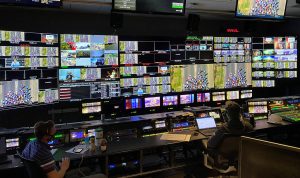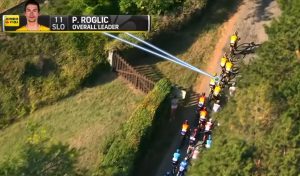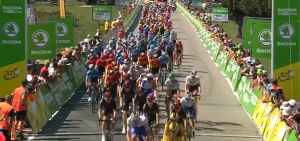Tour de France 2020: NBC Sports Group Leverages Stamford Broadcast Center for At-Home Production
Instead of three mobile units, the broadcaster travels a satellite-uplink truck over the route
Story Highlights
Shifting locations is nothing new for NBC Sports Group’s Tour de France production team. Each year, the crew follows the race from one stage to the next, performing a full set and strike each day, moving its caravan of trucks to the next finish-line location overnight, and doing it all over again the next day. This year, however, the production team has moved a bit farther away from the 21-stage course in France: more than 3,500 miles west to Stamford, CT.

NBC Sports’ Joel Felicio and the majority of the production team are producing the broadcast from a control room in Stamford.
With the pandemic wreaking havoc on travel and logistics, NBC Sports has opted to produce its Tour de France coverage out of its International Broadcast Center (IBC) in Stamford with a limited footprint in France. As a result, the Peacock sports team was tasked with devising a wholly new production workflow that matched the production quality of past years.
“We are all usually onsite for this, so everyone has had to figure out a new way to do all their jobs with COVID protocol,” says NBC Sports Coordinating Producer Joel Felicio. “We’ve had to pretty much rethink everything. It was a little scary in the lead-up, but, after that first show, we knew it was all going to work. I’m really proud of how it has turned out, and we’ve continued to improve throughout.”
A Connecticut Broadcaster in Tour de France’s Court
Instead of three onsite mobile units (main production unit, edit unit, and truck for the studio show) as in years past, Felicio and the majority of the production team are producing the broadcast from a control room in Stamford. The production crew replicates what would be inside the truck in France: producer Felicio, a director, TD, associate director, three EVS replay operators, graphics operator, graphics PA, and audio mixer.
To send camera/audio feeds to Stamford, NBC parks a satellite-uplink truck at the finish line each day with connectivity to the IBC. A TD inside the uplink truck is in direct contact with the control room in Stamford, which indicates which feeds should be sent at any given moment.

NBC is using its International Broadcast Center in Stamford, CT, as the home for its Tour de France production.
NBC has three transmission paths from France: a clean feed provided by race organizer Amaury Sports Organization (CLICK HERE for SVG Europe’s story on the world feed), a multiviewer that allows the production team to view all the available sources, and a path to switch between individual camera feeds depending on the situation. A TD inside the uplink truck is in direct contact with the Stamford control room and has access to two helicopter cams, five RF motorcycle cameras, and several other sources to send.
“At the finish line, all the [sources] that we would normally have onsite in our OB production truck is going into an uplink truck,” says Felicio. “And the full production workflow is based in our control room in Stamford.”
Live From France: Small Crew Goes Inside the Peloton
Onsite in France, NBC has deployed a five-person crew at the start line each day: onsite reporter Adam Blythe, a producer, ENG cameras, audio mixer, and production assistant. This crew produces start-line interviews each day and delivers them to the SPOC via a LiveU bonded-cellular transmission system.
NBC has brought back several of the production elements deployed for the Tour de France in previous years, including live coverage from cameras mounted on several competitors’ bicycles. NBC deploys eight 5G-based bike-cam systems each day, rotating them among the riders.
“We’re excited to have that back, and it’s getting into the show a lot,” says Felicio. “That’s really cool because you get a different angle and can get the perspective from right in the peloton. Sometimes, I ask the [announcers] to stay silent so we can actually listen to what’s going on in the peloton, which is always interesting, because you can hear the brakes and the wind and the nat sounds. It’s really amazing.”
NBC’s popular 3D animated maps, which track where the riders are on the route in real time, are back again this year (with the operator located onsite) along with real-time data on course gradients.
SMT Pitches in Graphics, Data Feeds From Durham
NBC’s multi-site workflow isn’t limited to Stamford and France, however. SMT, which provides graphics and data feeds for NBC’s coverage each year, is handling its portion of the show out of its own remote control room in Durham, NC. (CLICK HERE for SVG’s story on SMT’s role.)
SMT provides broadcast graphics that display the ever-changing road gradients and the cyclists’ speeds. Time-trial graphics include predicted finish times, the time each rider must finish to take the yellow jersey, and a comparison of two riders to determine who is fastest on specific sections of the course. SMT’s Iso Track System allows viewers to follow the cyclists with an on-screen pointer graphic that displays names, rankings, headshots, real-time speeds, and gradients.
Other broadcast features from SMT include prompters for commentators, featuring storytelling elements (including a leaderboard that tracks riders for each group based on the stage profile); full-screen graphics with race-stage profiles showing the layout of the current stage and rider progression; lower-thirds and leaderboard graphics; a production telestrator; and onscreen clocks and time-trial graphics.
From France to Stamford to London: On-Air Talent Goes Transcontinental
As for on-air talent, play-by-play announcer Phil Liggett is calling the race from Sky Sports’ studios in the UK (where he lives), while analyst Bob Roll joins Liggett on the call remotely from Stamford.
“It’s amazing how seamless [remote commentary] has been,” says Felicio. “There’s no delay, and [Liggett and Roll] couldn’t believe it. We gave them both little snoop cameras, so they can see each other for confidence. To be honest, It has been even smoother than I thought it would be from day one, and it looks great on TV.”
Also in Stamford, Paul Burmeister hosts daily pre-race and post-race studio coverage, along with analysts Christian Vande Velde and Chris Horner. In France, Blythe regularly is offering real-time reports while traveling aboard a motorcycle on the course.
As the NBC Sports team heads into the closing weekend of the Tour de France, Felicio says that, despite the challenges of a decentralized production model, he has been thrilled with NBC’s coverage thus far.
“The technical people that are in the building here at NBC are absolutely amazing,” says Felicio. “Any kind of potential problem that I raise from the technical side, they have had a solution. And then, everybody on the production side has been working as hard as they possibly can. It’s long hours and not a lot of sleep [with the time difference]. I’m really proud of everyone.”


